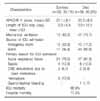Abstract
Background
The management of patients with lung cancer has improved recently, and many of them will require admission to the medical intensive care unit (MICU). The aim of this study was to examine the clinical characteristics and to identify risk factors for mortality in patients with lung cancer admitted to the MICU.
Methods
We conducted retrospective analysis on 88 patients with lung cancer admitted to the MICU between April 2004 and March 2008.
Results
Of the 88 patients (mean age, 66 years), 71 patients (80.7%) had non-small cell lung cancer and 17 patients (19.3%) had small cell lung cancer. Distant metastasis were present in 79 patients (89.8%). The main reasons for MICU admission were acute respiratory failure (77.3%), sepsis (11.4%), and central nervous system dysfunction (4.5%). Mechanical ventilation was used in 54 patients (61.4%). Acute Physiology and Chronic Health Evaluation (APACHE) II score, length of MICU stay, need for mechanical ventilation, source of MICU admission were correlated with MICU mortality. The type of lung cancer and metastasis were not predictive factors of death in MICU.
Figures and Tables
References
1. Soares M, Darmon M, Salluh J, Ferreira C, Thiéry G, Schlemmer B, et al. Prognosis of lung cancer patients with life-threatening complications. Chest. 2007. 131:840–846.
2. Adam AK, Soubani AO. Outcome and prognostic factors of lung cancer patients admitted to the medical intensive care unit. Eur Respir J. 2008. 31:47–53.
3. Reichner CA, Thompson JA, O'Brien S, Kuru T, Anderson ED. Outcome and code status of lung cancer patients admitted to the medical ICU. Chest. 2006. 130:719–723.
4. Sharma G, Freeman J, Zhang D, Goodwin JS. Trends in end-of-life ICU use among older adults with advanced lung cancer. Chest. 2008. 133:72–78.
5. Boussat S, El'rini T, Dubiez A, Depierre A, Barale F, Capellier G. Predictive factors of death in primary lung cancer patients on admission to the intensive care unit. Intensive Care Med. 2000. 26:1811–1816.
6. Claessens MT, Lynn J, Zhong Z, Desbiens NA, Phillips RS, Wu AW, et al. Dying with lung cancer or chronic obstructive pulmonary disease: insight from SUPPORT. Study to understand prognoses and preferences for outcomes and risks of treatments. J Am Geriatr Soc. 2000. 48:S146–S153.
7. Mountain CF. Revision in the international system for staging lung cancer. Chest. 1997. 111:1710–1717.
8. Demetri G, Elias A, Gershenson D, Fossella F, Grecula J, Mittal B, et al. NCCN Small-cell lung cancer practice guidelines. The national comprehensive cancer network. Oncology. 1996. 10:179–194.
9. Lim JH, Ban HJ, Oh IJ, Kim SO, Son JG, Jong PJ, et al. Clinical characteristics of lung cancer diagnosed in Chonnam National University Hospital (CNUH) since 2000. Tuberc Respir Dis. 2006. 61:427–432.
10. Korea National Statistical Office. Annual report on the cause of death statistics. 2006. Daejeon: Korea National Statistical Office;333.
11. Thiéry G, Azoulay E, Darmon M, Ciroldi M, de Miranda S, Lévy V, et al. Outcome of cancer patients considered for intensive care unit admission: a hospital-wide prospective study. J Clin Oncol. 2005. 23:4406–4413.
12. Larché J, Azoulay E, Fieux F, Mesnard L, Moreau D, Thiery G, et al. Improved survival of critically ill cancer patients with septic shock. Intensive Care Med. 2003. 29:1688–1695.
13. Kress JP, Christenson J, Pohlman AS, Linkin DR, Hall JB. Outcomes of critically ill cancer patients in a university hospital setting. Am J Respir Crit Care Med. 1999. 160:1957–1961.
14. Groeger JS, White P Jr, Nierman DM, Glassman J, Shi W, Horak D, et al. Outcome for cancer patients requiring mechanical ventilation. J Clin Oncol. 1999. 17:991–997.
15. Lin YC, Tsai YH, Huang CC, Hsu KH, Wang SW, Tsao TC, et al. Outcome of lung cancer patients with acute respiratory failure requiring mechanical ventilation. Respir Med. 2004. 98:43–51.
16. Soares M, Salluh JI, Spector N, Rocco JR. Characteristics and outcomes of cancer patients requiring mechanical ventilatory support for >24 hrs. Crit Care Med. 2005. 33:520–526.
17. Lecuyer L, Chevret S, Thiery G, Darmon M, Schlemmer B, Azoulay E. The ICU trial: a new admission policy for cancer patients requiring mechanical ventilation. Crit Care Med. 2007. 35:808–814.
18. Jennens RR, Rosenthal MA, Mitchell P, Presneill JJ. Outcome of patients admitted to the intensive care unit with newly diagnosed small cell lung cancer. Lung Cancer. 2002. 38:291–296.
19. Janssen-Heijnen ML, Schipper RM, Razenberg PP, Crommelin MA, Coebergh JW. Prevelence of co-morbidity in lung cancer patients and its relationship with treatment: a population-based study. Lung Cancer. 1998. 21:105–113.
20. Jeong ET. Clinical survey of lung cancer in Korea. Tuberc Respir Dis. 2000. 49:137–148.
21. Martin CM, Hill AD, Burns K, Chen LM. Characteristics and outcomes for critically ill patients with prolonged intensive care unit stays. Crit Care Med. 2005. 33:1922–1927.
22. Soares M, Salluh JI, Torres VB, Leal JV, Spector N. Short- and long-term outcomes of critically ill patients with cancer and prolonged ICU length of stay. Chest. 2008. 134:520–526.
23. Delle Karth G, Meyer B, Bauer S, Nikfardjam M, Heinz G. Outcome and functional capacity after prolonged intensive care unit stay. Wien Klin Wochenschr. 2006. 118:390–396.
24. Friedrich JO, Wilson G, Clarence C. Long-term outcomes and clinical predictors of hospital mortality in very long stay intensive care unit patients: a cohort study. Critical Care. 2006. 10:R59.
25. Griffin JP, Nelson JE, Koch KA, Niell HB, Ackerman TF, Thompson M, et al. End-of-life care in patients with lung cancer. Chest. 2003. 123:312S–331S.




 PDF
PDF ePub
ePub Citation
Citation Print
Print







 XML Download
XML Download